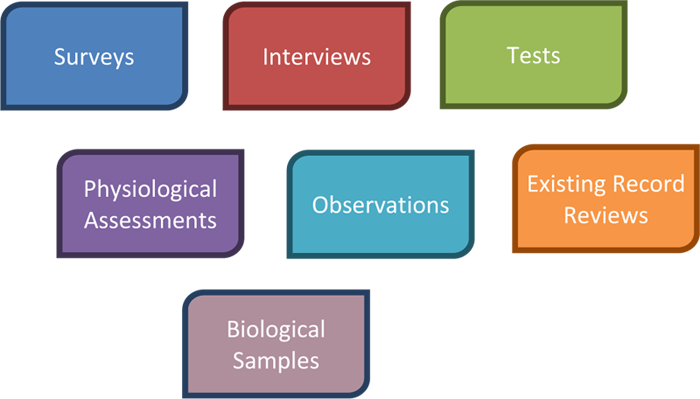Module 4: Methods of Information Collection - Section 1
Section 1: Examples of Information Collection Methods
 There are many ways to collect information in research. The method that is chosen by the researcher depends on the research question that is being asked. Examples of information collection methods include surveys, interviews, tests, physiological assessments, observations, existing record reviews and biological samples.
There are many ways to collect information in research. The method that is chosen by the researcher depends on the research question that is being asked. Examples of information collection methods include surveys, interviews, tests, physiological assessments, observations, existing record reviews and biological samples.
A survey is a set of questions for research participants to answer. Surveys can be administered in person, through the mail, telephone or electronically (e-mail or Internet). A survey can be administered to an individual or in a group setting. Surveys are used to gain information about many individuals and may include multiple/forced choice or open-ended questions (e.g., demographics , health, knowledge, opinions, beliefs, attitudes or skills).
An interview is an interaction that involves the researcher and the participant(s) in which questions are presented in person, over the telephone or even electronically (email or Internet). During an interview, questions are asked to obtain detailed information from the participant about the topic under study. The questions may be similar to those asked in a survey.
A test is a form or a physical or mental task for which a normal standard has been determined or for which there are correct answers. A participant's performance on the test is then compared to these standards and/or correct answers. Tests are used in research to determine a participant's aptitude, skill, knowledge, health, or mental status as compared to the general population. Tests can be administered in person or through a paper or electronic medium. An example would be students taking a standardized test for academic achievement (e.g., SAT, MCAT, GRE).
Physiological assessments are measurements in which a participant's physical characteristics are evaluated such as blood pressure, heart rate, or physical strength. In health-related research, physiological assessment may be used to determine the participant's health status prior to, during, or after the completion of the study. An example would be older adults touching their toes to assess flexibility and reach.
Observations are recordings that are taken of the participant without requiring interaction. These recordings are made while participants are engaged in routine behaviors and are used as an indicator of what participants actually do rather than relying completely on self-reports of participants' behaviors. An example would be a researcher observing an ongoing lesson plan used in a classroom by a public school teacher.
Record reviews take place when the researcher examines and extracts information from documents that include information about the participant. Records that are reviewed in research may be either public or private. An example is a researcher collecting information about a disease from patient medical records.
Biological samples are substances (blood, urine, saliva) that are taken from an individual and used to measure physiological information. An example would be drawing blood to assess the sugar content in a diabetic patient.
No matter what kind of information is collected in a research study or how it is collected, it is extremely important to carry out the collection of the information with precision (i.e., reliability), accuracy (i.e., validity), and minimal error. The integrity and usefulness of the research may be compromised if the study measurements are not carried out correctly. Factors that contribute to effective information gathering are discussed in the next few sections.





